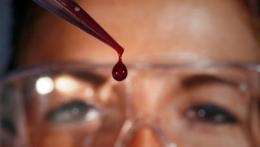How many cells can our blood tolerate?

Bioinformaticians of Jena University (Germany) have found out that the optimal value of hematocrit -- which indicates the volume fraction of the red blood cells -- can be calculated with an equation that dates from no less a person than Albert Einstein. The red blood cells form the greatest part of bloods solid components -- all in all around 40 percent of the blood. The percentage of this component is not only similar in all human beings but also in many other vertebrates.
When people say "Blood is thicker than water," they are literally right. Because nearly half of the 'life liquid' consists of solid components. The red blood cells form the greatest part of it – all in all around 40 percent of the blood. They contain the red pigment hemoglobin and are responsible for the transport of oxygen.
"It is amazing that the percentage of this component is not only similar in all human beings but also in many other vertebrates," Prof. Dr. Stefan Schuster of the Friedrich Schiller University Jena (Germany) says. Therefore it can be assumed that this value represents an optimum established by evolution. "If there was a lower volumetric content of blood cells, less oxygen would be transported," the chair of Bioinformatics of the Biological Pharmaceutical Faculty says. "If there was a higher content, the oxygen transport would be increased. But as the blood would then be more viscous, the speed of transport would go down at the same time."
As Prof. Schuster and his colleague Dr. Heiko Stark have just found out, the optimal value of hematocrit – which indicates the volume fraction of the red blood cells – can be calculated with an equation that dates from no less a person than Albert Einstein. The ingenious scientist engaged himself not only in the theory of relativity and quantum physics but also in the viscosity of liquids. "There are already a number of theoretical attempts for calculating the optimal hematocrit value in specialist literature," Schuster says. The Bioinformaticians of Jena University tried to find out which of those equations would be best suited to express the dependence of the viscosity on the liquid (blood) of the volume of the particles (blood cells) and struck lucky with Einstein. The Jena scientists published their results in the latest edition of the science magazine Journal of Applied Physiology.
According to this the viscosity of a liquid is dependent on the viscosity of the solvent and the percentage volume of their solid components. Moreover Einstein's equation also has the factor 2.5. "If you apply a modification of this equation suggested by Arrhenius to the equation describing the speed of transport and establish the maximum, you obtain the optimum of exactly 40 percent," Dr. Stark says and calculates: 1 divided by 2.5 equals 0.4 or 40 percent. Therefore the normal hematocrit of human beings seems to be optimal from the point of view of fluid dynamics as well. This would also explain why the same value can be found in many animal species like for instance in lions, antelopes, goats, elephants and rabbits.
In their article the Bioinformaticists listed the experimentally calculated hematocrit values of a total of 57 species of vertebrates from the literature. "However there are some aberrations from the optimum," Stark points out. The hematocrit of seals for instance is considerably higher with 63 percent. "Additional criteria might apply in this case." Marine mammals for instance need a bigger capacity to store oxygen as they dive for long periods of time.
With their results the Jena scientists also question the illegal practice of blood doping in sports: This means trying to raise the concentration of the oxygen transporting hemoglobin in the blood and thereby trying to increase the athlete's performance. This leads to an artificial increase of the hematocrit value. "This is not only a criminal offence, but at the same time its physiological effect is highly questionable according to our calculations", Prof. Schuster summarizes.
More information: H. Stark, S. Schuster, Comparison of various approaches to calculating the optimal hematocrit in vertebrates, J. Appl. Physiol. 2012, DOI: 10.1152/japplphysiol.00369.2012














